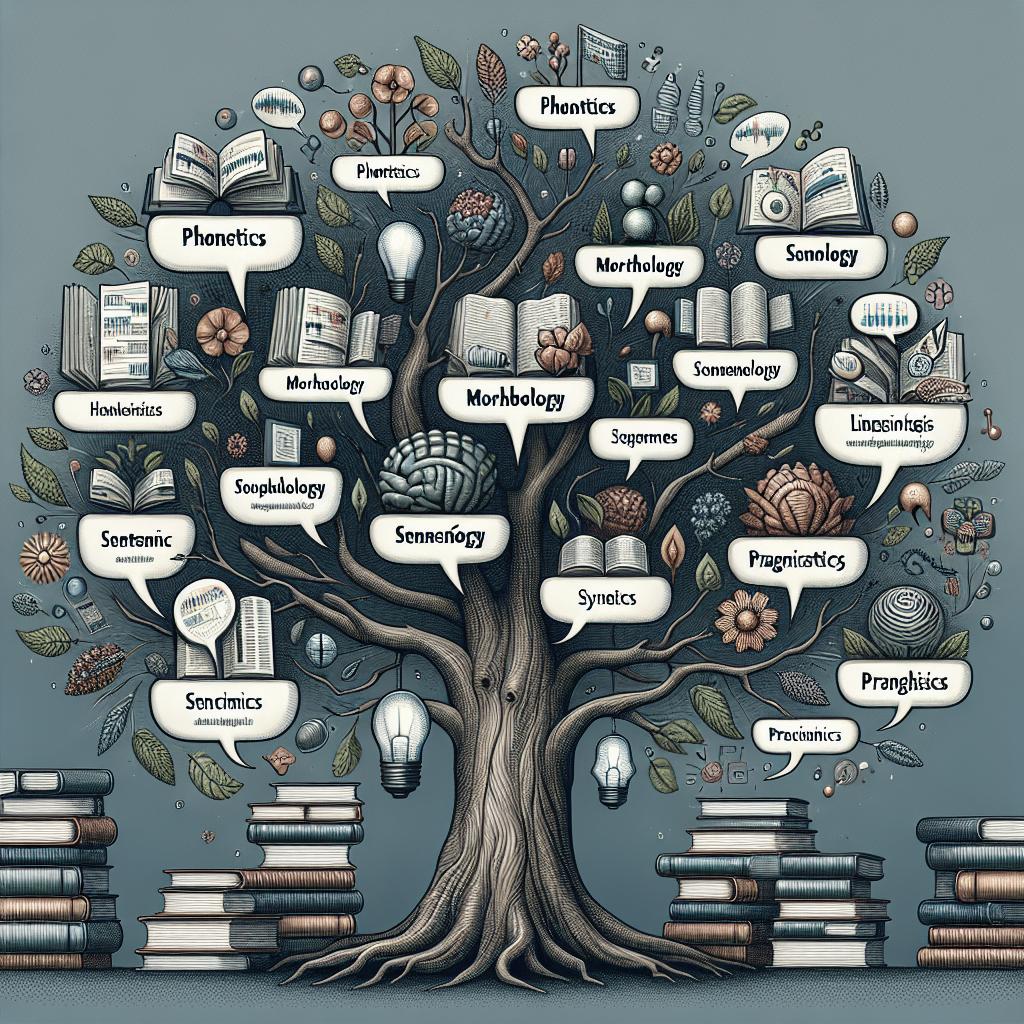<>
« `
Introduction
Linguistic anthropology is an intriguing subfield of anthropology that explores the intricate relationship between language and culture. This article navigates through the fundamental principles of linguistic anthropology, encompassing a variety of sub-disciplines and perspectives. From defining linguistic anthropology and its close kin, psychological anthropology, to delving into the nature of language with contributions from illustrious scholars like Noam Chomsky, we take a comprehensive tour through the field. We also touch upon the classification of human languages, sociolinguistic perspectives, language mixtures, and the tools of linguistic studies like phonology, morphology, syntax, semantics, and pragmatics. In essence, we aim to weave together a thorough understanding of how language operates within broader social contexts, shaping and being shaped by human behavior and culture.
Linguistic Anthropology Definition
Linguistic anthropology is the interdisciplinary study of how language influences social life. It focuses on the ways in which language intersects with cultural norms and societal structures. This field not only examines the mechanics of language but also its role in conveying and constructing meaning within cultures. Through immersive methods like participant observation and ethnography, linguistic anthropologists seek to understand how language functions in real-world settings. They study speech communities, analysis of discourse, and the use of language in various social contexts to reveal how it reflects and shapes societal values and power dynamics.
Linguistic Anthropology
Linguistic anthropology overlaps with several other subfields of anthropology such as cultural and social anthropology. It investigates language to uncover the wider cultural practices of communities, looking at aspects such as rituals, traditions, and social norms. The study often involves a deep dive into oral traditions and norms of communication to capture the essence of a culture. An essential aspect of this discipline is its focus on how different cultures categorize and understand the world through language. By analyzing linguistic structures, anthropologists uncover different cultural perceptions and cognitive frameworks which, in turn, can offer profound insights into the human experience.
Psychological Anthropology
Psychological anthropology intersects with linguistic anthropology by exploring how language shapes and is shaped by human psychology. It investigates how cultural factors influence mental processes and behaviors, specifically through the lens of language. This subfield provides a unique perspective on the cognitive aspects of language and communication. Psychological anthropologists might study how cultural narratives influence an individual’s perception of reality or how language development is impacted by cultural variables. By understanding these links, these researchers contribute to broader discussions about human cognition and cultural diversity.
The Nature of Language
Definitions
Language can be complex, operating on multiple levels from basic phonetics to intricate social functions. Fundamentally, language is a system of symbols and rules that allows humans to communicate meaning. These symbols can be sounds, written characters, or gestures, each governed by conventional rules within a particular speech community. Beyond its primary function of communication, language plays a crucial role in identity formation, social integration, and cultural transmission. It’s an adaptive tool that evolves and transforms with cultural and societal changes, ensuring its relevance and continued usage.
20th-Century Delineations
The 20th century marked a significant paradigm shift in the study of linguistics with the introduction of structuralism by Ferdinand de Saussure. This approach focused on understanding language as a system of interrelated elements, rather than merely a collection of words and rules. Structuralism emphasized the importance of the underlying structure that governs the relationships between linguistic signs. Simultaneously, the century saw the rise of functionalism, where scholars like Bronislaw Malinowski highlighted the context-dependent nature of language. The language was seen not just as a system, but as a vital social tool used to perform various social functions and activities.
Formal Linguistics
Formal linguistics emerged to explore the abstract structures underlying languages, concentrating on syntax, phonology, morphology, and semantics. This perspective treats language more like a formal system of rules and symbols, where the primary goal is to understand the universals that underlie all human languages. Formal linguistics has made significant contributions to our understanding of how languages function similarly across diverse cultures. It has provided a framework for analyzing the similarities and differences between languages, enabling linguists to develop comprehensive models of linguistic structure.
Noam Chomsky
Noam Chomsky, a seminal figure in linguistics, revolutionized the field with his theory of Universal Grammar. Chomsky proposed that the ability to learn language is innate to humans and that all languages share a common underlying structure. His theories shifted the focus from descriptive to generative linguistics, emphasizing the cognitive processes involved in language production and comprehension. Chomsky’s work highlighted the mentalist approach to language, positing that understanding language involves exploring the mind’s capacity to generate an infinite number of sentences from a finite set of elements. This perspective has been highly influential in both linguistics and cognitive science.
Language Competence and the Sentence
Language competence refers to a speaker’s implicit understanding of their language’s structure, enabling them to produce and interpret sentences correctly. This concept is central to Chomsky’s theory, where linguistic competence is distinguished from linguistic performance, or the actual use of language in communication. Exploring sentence structure, linguists investigate how sentences are formed and understood. This involves analyzing syntax – the set of rules that govern sentence formation. Understanding sentence structure helps in constructing grammars that describe the permissible combinations within a language.
Functional Linguistics
Functional linguistics takes a different approach by focusing more on the purposes and functions of language in communication. Language is seen not just as a set of abstract rules but as a dynamic tool used by individuals to achieve specific communicative goals in various contexts. This perspective emphasizes the socio-cultural functions of language, looking at how different languages and dialects perform various roles in society. It explores how language can convey social meanings, establish identities, and maintain social relationships.
Classification of Human Languages
Structural and Comparative Linguistics
Structural linguistics analyzes language based on its form and structure, categorizing languages according to specific features such as phonetics, syntax, and morphology. Comparative linguistics, on the other hand, looks at languages’ evolution and relationships, tracing common ancestries and reconstructing ancient languages. Together, these approaches offer a comprehensive understanding of how languages are structured and related. By comparing languages, linguists can uncover general principles of language change and development, providing insights into the history of human communication.
Sociolinguistic Perspectives
Sociolinguistics examines the relationship between language and society, exploring how social factors such as ethnicity, class, gender, and age influence language use and variation. This field highlights the diversity within languages and how different social groups may have distinct ways of speaking. Understanding these variations helps in appreciating the complexity of languages and the social dynamics that underpin linguistic practices. It also sheds light on issues such as language policy, dialectology, and linguistic discrimination.
Language Mixtures
Language mixtures occur when speakers of different languages come into contact, leading to the creation of mixed languages. These languages can incorporate elements from multiple languages, resulting in unique linguistic systems that reflect the blending of cultures and identities. Studies of mixed languages provide insights into how languages influence each other and adapt to changing social environments. They reveal the fluidity of language boundaries and the innovative ways in which speakers navigate multicultural contexts.
Pidgins and Creoles
Pidgins are simplified languages that develop as means of communication between speakers of different native languages. Creoles, on the other hand, are fully developed languages that evolve from pidgins when they become the first language of a community. The study of pidgins and creoles offers valuable insights into language formation, change, and the processes of linguistic simplification and elaboration. These languages are crucial in understanding the dynamics of language contact and social integration.
Linguistics and Politics
Language is inherently political, and linguistics often intersects with issues of power, identity, and social justice. Sociolinguists explore how language policies and practices can reinforce or challenge social hierarchies and inequalities. This field also investigates language activism and efforts to preserve and revitalize endangered languages, highlighting the political dimensions of language in maintaining cultural diversity and resisting linguistic imperialism.
Language Extinction
Language extinction occurs when a language loses its last native speakers and becomes no longer in use. This phenomenon is often a result of cultural assimilation, globalization, and the dominance of major world languages. The loss of a language is a loss of cultural heritage and knowledge. Linguists and anthropologists are working to document and revitalize endangered languages, preserving linguistic diversity and the cultural identities tied to these languages.
Psycholinguistics
Psycholinguistics investigates the cognitive processes behind language acquisition, production, and comprehension. This field bridges linguistics with psychology, exploring how the brain processes linguistic information and how language is learned and used by individuals. Research in psycholinguistics has uncovered important insights into the nature of language learning, the mental representations of linguistic structures, and the neural mechanisms underlying language use. This interdisciplinary approach enhances our understanding of both the mind and language.
Language Identification and Tools of Linguistic Studies
Phonology
Phonology is the study of the sound systems of languages. It examines how sounds function within particular languages and the rules that govern their distribution and patterning. Phonologists analyze aspects such as phonemes, syllable structure, stress, intonation, and phonological processes. By understanding these sound systems, linguists can describe the phonetic and phonological features that distinguish one language from another. This helps in the documentation and classification of languages and provides insights into the cognitive processes that underpin speech.
Morphology
Morphology is the study of the structure and formation of words. It explores how morphemes – the smallest units of meaning – combine to form words and how these words can be altered to express different grammatical categories such as tense, number, and case. Morphological analysis reveals the intricate ways in which languages encode meaning and grammatical relations. It provides a window into the creativity of word formation and the diversity of linguistic structures across languages.
Syntax
Syntax is the study of sentence structure and the rules that govern the combination of words into phrases and sentences. Syntacticians analyze the hierarchical organization of sentences, exploring how different elements of a sentence relate to each other. Understanding syntax is crucial for describing how languages construct meaning through sentence structure. It helps in identifying universal principles of grammar and explaining cross-linguistic similarities and differences.
Semantics and Pragmatics
Semantics is the study of meaning in language. It examines how words, phrases, and sentences convey meaning and how these meanings can be interpreted in different contexts. Pragmatics, on the other hand, focuses on how language is used in communication and the ways in which context influences meaning. Together, semantics and pragmatics provide a comprehensive understanding of how language communicates meaning and how speakers use linguistic resources to achieve communicative goals. They highlight the interplay between linguistic form, meaning, and use.
Lessons Learned
| Title | Key Points |
|---|---|
| Linguistic Anthropology Definition | Explores the relationship between language and culture; uses participant observation and ethnography to study real-world language use. |
| Linguistic Anthropology | Investigates language to uncover cultural practices; focuses on categorization and cognitive frameworks through linguistics. |
| Psychological Anthropology | Explores the interaction between language and human psychology; studies cultural narratives and language development. |
| The Nature of Language | Defines language as a system of symbols and rules; 20th-century paradigms like structuralism and functionalism; highlights Chomsky’s contributions and language competence. |
| Classification of Human Languages | Analyzes languages based on structure and comparative methods; studies language mixtures, pidgins, creoles, socio-political aspects, and language extinction. |
| Language Identification and Tools of Linguistic Studies | Examines phonology, morphology, syntax, semantics, and pragmatics to identify and analyze linguistic structures and meanings. |
« `


